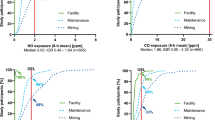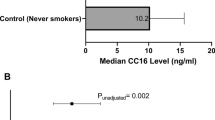Abstract
Purpose
World Trade Center (WTC) exposure caused airflow obstruction years after exposure. Chitinases and IgE are innate and humoral mediators of obstructive airway disease. We investigated if serum expression of chitinases and IgE early after WTC exposure predicts subsequent obstruction.
Methods
With a nested case–control design, 251 FDNY personnel had chitotriosidase, YKL-40 and IgE measured in serum drawn within months of 9/11/2001. The main outcome was subsequent Forced Expiratory Volume after 1 second/Forced Vital Capacity (FEV1/FVC) less than the lower limit of normal (LLN). Cases (N = 125) had abnormal FEV1/FVC whereas controls had normal FEV1/FVC (N = 126). In a secondary analysis, resistant cases (N = 66) had FEV1 (≥107 %) one standard deviation above the mean. Logistic regression adjusted for age, BMI, exposure intensity and post-exposure FEV1/FVC modeled the association between early biomarkers and later lung function.
Results
Cases and Controls initially lost lung function. Controls recovered to pre-9/11 FEV1 and FVC while cases continue to decline. Cases expressed lower serum chitotriosidase and higher IgE levels. Increase in IgE increased the odds of airflow obstruction and decreased the odds of above average FEV1. Alternately, increasing chitotriosidase decreased the odds of abnormal FEV1/FVC and increased the odds of FEV1 ≥ 107 %. Serum YKL-40 was not associated with FEV1/FVC or FEV1 in this cohort.
Conclusions
Increased serum chitotriosidase reduces the odds of developing obstruction after WTC-particulate matter exposure and is associated with recovery of lung function. Alternately, elevated IgE is a risk factor for airflow obstruction and progressive lung function decline.


Similar content being viewed by others
References
Prezant DJ, Weiden M, Banauch GI, McGuinness G, Rom WN, Aldrich TK, et al. Cough and bronchial responsiveness in firefighters at the World Trade Center site. N Engl J Med. 2002;347(11):806–15. PubMed PMID: 12226151.
Banauch GI, Dhala A, Alleyne D, Alva R, Santhyadka G, Krasko A, et al. Bronchial hyperreactivity and other inhalation lung injuries in rescue/recovery workers after the World Trade Center collapse. Crit Care Med. 2005;33(1 Suppl):S102–6. PubMed PMID: 15640671.
Banauch GI, Hall C, Weiden M, Cohen HW, Aldrich TK, Christodoulou V, et al. Pulmonary function after exposure to the World Trade Center collapse in the New York City Fire Department. Am J Respir Crit Care Med. 2006;174(3):312–9. PubMed PMID: 16645172. Pubmed Central PMCID: 2648115.
Feldman DM, Baron SL, Bernard BP, Lushniak BD, Banauch G, Arcentales N, et al. Symptoms, respirator use, and pulmonary function changes among New York City firefighters responding to the World Trade Center disaster. Chest. 2004;125(4):1256–64. PubMed PMID: 15078732.
Banauch GI, Alleyne D, Sanchez R, Olender K, Cohen HW, Weiden M, et al. Persistent hyperreactivity and reactive airway dysfunction in firefighters at the World Trade Center. Am J Respir Crit Care Med. 2003;168(1):54–62. PubMed PMID: 12615613.
Reibman J, Lin S, Hwang SA, Gulati M, Bowers JA, Rogers L, et al. The World Trade Center residents’ respiratory health study: new-onset respiratory symptoms and pulmonary function. Environ Heal Perspect. 2005;113(4):406–11. PubMed PMID: 15811830. Pubmed Central PMCID: 1278479.
(CDC) CfDCaP. Self-reported increase in asthma severity after the September 11 attacks on the World Trade Center-Manhattan, New York. JAMA. 2002;288(12):1466–7.
Aldrich TK, Gustave J, Hall CB, Cohen HW, Webber MP, Zeig-Owens R, et al. Lung function in rescue workers at the World Trade Center after 7 years. N Engl J Med. 2010;362(14):1263–72. PubMed PMID: 20375403.
Weiden MD, Naveed B, Kwon S, Cho SJ, Comfort AL, Prezant DJ, et al. Cardiovascular biomarkers predict susceptibility to lung injury in World Trade Center dust-exposed firefighters. Eur Respir J. 2013;41(5):1023--30. PubMed PMID: 22903969.
Nolan A, Naveed B, Comfort AL, Ferrier N, Hall CB, Kwon S, et al. Inflammatory biomarkers predict airflow obstruction after exposure to World Trade Center dust. Chest. 2012;142(2):412–8. PubMed PMID: 21998260. Pubmed Central PMCID: 3425337.
Naveed B, Weiden MD, Kwon S, Gracely EJ, Comfort AL, Ferrier N, et al. Metabolic syndrome biomarkers predict lung function impairment: a nested case–control study. Am J Respir Crit Care Med. 2012;185(4):392–9. PubMed PMID: 22095549. Pubmed Central PMCID: 3297095.
Seibold MA, Donnelly S, Solon M, Innes A, Woodruff PG, Boot RG, et al. Chitotriosidase is the primary active chitinase in the human lung and is modulated by genotype and smoking habit. J Allergy Clin Immunol. 2008;122(5):944–50 e3. PubMed PMID: 18845328. Pubmed Central PMCID: 2666777.
Aminuddin F, Akhabir L, Stefanowicz D, Pare PD, Connett JE, Anthonisen NR, et al. Genetic association between human chitinases and lung function in COPD. Hum Genet. 2012;131(7):1105–14. PubMed PMID: 22200767.
Bussink AP, Speijer D, Aerts JM, Boot RG. Evolution of mammalian chitinase(−like) members of family 18 glycosyl hydrolases. Genetics. 2007;177(2):959–70. PubMed PMID: 17720922. Pubmed Central PMCID: 2034658. Epub 2007/08/28. eng.
Funkhouser JD, Aronson Jr NN. Chitinase family GH18: evolutionary insights from the genomic history of a diverse protein family. BMC Evol Biol. 2007;7:96. PubMed PMID: 17594485. Pubmed Central PMCID: 1945033. Epub 2007/06/28. eng.
Araujo AC, Souto-Padron T, de Souza W. Cytochemical localization of carbohydrate residues in microfilariae of Wuchereria bancrofti and Brugia malayi. J Histochem Cytochem Off J Histochem Soc. 1993;41(4):571–8. PubMed PMID: 8450196.
Debono M, Gordee RS. Antibiotics that inhibit fungal cell wall development. Annu Rev Microbiol. 1994;48:471–97. PubMed PMID: 7826015.
Fuhrman JA, Piessens WF. Chitin synthesis and sheath morphogenesis in Brugia malayi microfilariae. Mol Biochem Parasitol. 1985;17(1):93–104. PubMed PMID: 3932852.
Neville AC, Parry DA, Woodhead-Galloway J. The chitin crystallite in arthropod cuticle. J Cell Sci. 1976;21(1):73–82. PubMed PMID: 932111.
Shahabuddin M, Kaslow DC. Plasmodium: parasite chitinase and its role in malaria transmission. Exp Parasitol. 1994;79(1):85–8. PubMed PMID: 7914174.
Ober C, Tan Z, Sun Y, Possick JD, Pan L, Nicolae R, et al. Effect of variation in CHI3L1 on serum YKL-40 level, risk of asthma, and lung function. N Engl J Med. 2008;358(16):1682–91. PubMed PMID: 18403759. Pubmed Central PMCID: 2629486.
Chupp GL, Lee CG, Jarjour N, Shim YM, Holm CT, He S, et al. A chitinase-like protein in the lung and circulation of patients with severe asthma. N Engl J Med. 2007;357(20):2016–27. PubMed PMID: 18003958.
Sohn MH, Lee JH, Kim KW, Kim SW, Lee SH, Kim KE, et al. Genetic variation in the promoter region of chitinase 3-like 1 is associated with atopy. Am J Respir Crit Care Med. 2009;179(6):449–56. PubMed PMID: 19106306.
Lee CG, Elias JA. Role of breast regression protein-39/YKL-40 in asthma and allergic responses. Allergy Asthma Immunol Res. 2010;2(1):20–7. PubMed PMID: 20224674. Pubmed Central PMCID: 2831605.
Lee CG, Dela Cruz CS, Herzog E, Rosenberg SM, Ahangari F, Elias JA. YKL-40, a chitinase-like protein at the intersection of inflammation and remodeling. Am J Respir Crit Care Med. 2012;185(7):692–4. PubMed PMID: 22467800.
Di Rosa M, Musumeci M, Scuto A, Musumeci S, Malaguarnera L. Effect of interferon-gamma, interleukin-10, lipopolysaccharide and tumor necrosis factor-alpha on chitotriosidase synthesis in human macrophages. Clin Chem Lab Med CCLM/FESCC. 2005;43(5):499–502. PubMed PMID: 15899671.
Malaguarnera L, Musumeci M, Di Rosa M, Scuto A, Musumeci S. Interferon-gamma, tumor necrosis factor-alpha, and lipopolysaccharide promote chitotriosidase gene expression in human macrophages. J Clin Lab Anal. 2005;19(3):128–32. PubMed PMID: 15900564.
Renkema GH, Boot RG, Muijsers AO, Donker-Koopman WE, Aerts JM. Purification and characterization of human chitotriosidase, a novel member of the chitinase family of proteins. J Biol Chem. 1995;270(5):2198–202. PubMed PMID: 7836450.
van Eijk M, van Roomen CP, Renkema GH, Bussink AP, Andrews L, Blommaart EF, et al. Characterization of human phagocyte-derived chitotriosidase, a component of innate immunity. Int Immunol. 2005;17(11):1505–12. PubMed PMID: 16214810.
Agapov E, Battaile JT, Tidwell R, Hachem R, Patterson GA, Pierce RA, et al. Macrophage chitinase 1 stratifies chronic obstructive lung disease. Am J Respir Cell Mol Biol. 2009;41(4):379–84. PubMed PMID: 19491341. Pubmed Central PMCID: 2746984.
Letuve S, Kozhich A, Humbles A, Brewah Y, Dombret MC, Grandsaigne M, et al. Lung chitinolytic activity and chitotriosidase are elevated in chronic obstructive pulmonary disease and contribute to lung inflammation. Am J Pathol. 2010;176(2):638–49. PubMed PMID: 20042671. Pubmed Central PMCID: 2808072.
Postma DS, Bleecker ER, Amelung PJ, Holroyd KJ, Xu J, Panhuysen CI, et al. Genetic susceptibility to asthma–bronchial hyperresponsiveness coinherited with a major gene for atopy. N Engl J Med. 1995;333(14):894–900. PubMed PMID: 7666875.
Beeh KM, Ksoll M, Buhl R. Elevation of total serum immunoglobulin E is associated with asthma in nonallergic individuals. Eur Respir J Off J Eur Soc Clin Respir Physiol. 2000;16(4):609–14. PubMed PMID: 11106200.
Sears MR, Burrows B, Flannery EM, Herbison GP, Hewitt CJ, Holdaway MD. Relation between airway responsiveness and serum IgE in children with asthma and in apparently normal children. N Engl J Med. 1991;325(15):1067–71. PubMed PMID: 1891008.
Busse WW, Morgan WJ, Gergen PJ, Mitchell HE, Gern JE, Liu AH, et al. Randomized trial of omalizumab (anti-IgE) for asthma in inner-city children. N Engl J Med. 2011;364(11):1005–15. PubMed PMID: 21410369. Pubmed Central PMCID: 3093964.
Hanania NA, Alpan O, Hamilos DL, Condemi JJ, Reyes-Rivera I, Zhu J, et al. Omalizumab in severe allergic asthma inadequately controlled with standard therapy: a randomized trial. Ann Intern Med. 2011;154(9):573–82. PubMed PMID: 21536936.
Renkema TE, Kerstjens HA, Schouten JP, Vonk JM, Koeter GH, Postma DS. The importance of serum IgE for level and longitudinal change in airways hyperresponsiveness in COPD. Clin Exp Allergy J Br Soc Allergy Clin Immunol. 1998;28(10):1210–8. PubMed PMID: 9824387.
Weiden MD, Ferrier N, Nolan A, Rom WN, Comfort A, Gustave J, et al. Obstructive airways disease with air trapping among firefighters exposed to World Trade Center dust. Chest. 2010;137(3):566–74. PubMed PMID: 19820077. Pubmed Central PMCID: 2832867.
Bargagli E, Maggiorelli C, Rottoli P. Human chitotriosidase: a potential new marker of sarcoidosis severity. Respir Int Rev Thorac Dis. 2008;76(2):234–8. PubMed PMID: 18487875.
Bargagli E, Bennett D, Maggiorelli C, Di Sipio P, Margollicci M, Bianchi N, et al. Human chitotriosidase: a sensitive biomarker of sarcoidosis. J Clin Immunol. 2013;33(1):264–70. PubMed PMID: 22878841.
Lee CG, Herzog EL, Ahangari F, Zhou Y, Gulati M, Lee CM, et al. Chitinase 1 is a biomarker for and therapeutic target in scleroderma-associated interstitial lung disease that augments TGF-beta1 signaling. J Immunol. 2012;189(5):2635–44. PubMed PMID: 22826322.
Labadaridis I, Dimitriou E, Theodorakis M, Kafalidis G, Velegraki A, Michelakakis H. Chitotriosidase in neonates with fungal and bacterial infections. Arch Dis Child Fetal Neonatal Ed. 2005;90(6):F531–2. PubMed PMID: 16244214. Pubmed Central PMCID: 1721954.
Author Contributions
conception and design, S.J.C, M.D.W., and A.N; analysis and interpretation, S.J.C., M.D.W., G.C.E., A.N., S.K.; drafting the manuscript for important intellectual content, S.J.C., M.D.W., A.N., S.K., E.S., J.T., D.J.P., W.N.R..
Disclosures
The authors of this manuscript have no actual or potential conflicts of interest to disclose.
Funding
K23HL084191 (AN), K24A1080298 (MDW), RO1HL057879; (MDW), HL090316, Al080298A, TL1RR029892; T32 ES007267 (BN, SJC); U01CA008617, RO1HL090316 (WNR), NIOSH/CDC (U10- OH008243, U10-OH008242), and 1 UL1RR029893. This work was also partially funded by the NYU-HHC Clinical and Translational Science Institute, supported in part by grant UL1TR000038 from the National Center for Advancing Translational Sciences of the National Institutes of Health. The funding agencies did not participate in the study design; in the collection, analysis and interpretation of data; in the writing of the report; and in the decision to submit the article for publication.
Author information
Authors and Affiliations
Corresponding author
Rights and permissions
About this article
Cite this article
Cho, S.J., Nolan, A., Echevarria, G.C. et al. Chitotriosidase is a Biomarker for the Resistance to World Trade Center Lung Injury in New York City Firefighters. J Clin Immunol 33, 1134–1142 (2013). https://doi.org/10.1007/s10875-013-9913-2
Received:
Accepted:
Published:
Issue Date:
DOI: https://doi.org/10.1007/s10875-013-9913-2




